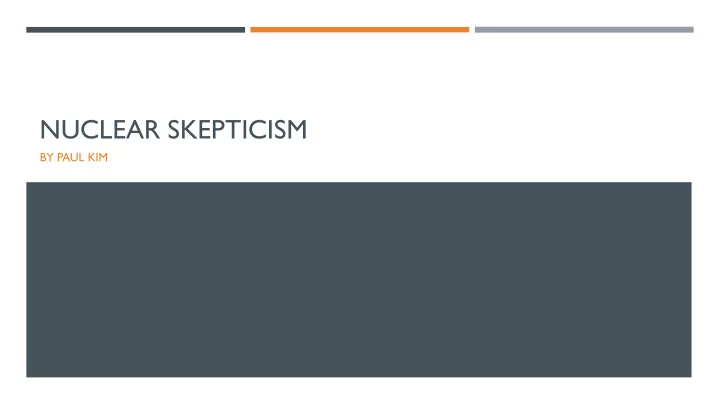

NUCLEAR SKEPTICISM BY PAUL KIM
RESEARCH QUESTION Questioning the Effect of Nuclear Weapons on Conflict (Mark S. Bell and Nicholas L. Miller) ¡ Q:What effect do nuclear weapons have on interstate conflict behavior? ¡ A:The conflict behavior of symmetric nuclear dyads appears much the same as that of non-nuclear dyads ¡
ANSWER EXPLAINED ¡ Dyads in which both states possess nuclear weapons are not significantly less likely to fight wars, nor are they significantly more or less belligerent at low levels of conflict ¡ Dyads in which one state possesses nuclear weapons are more prone to low-level conflict (but not more prone to war)
AUTHOR’S THEORY ¡ Optimists vs Pessimists ¡ Stability-instability paradox ¡ Defensive realism
AUTHOR’S THEORY Hypothesis 1: Symmetric nuclear dyads are more likely to experience conventional war and low-level conflict than are ¡ nonnuclear dyads Hypothesis 2: Symmetric nuclear dyads are less likely to experience all levels of conflict than are nonnuclear dyads ¡ Hypothesis 3: Symmetric nuclear dyads are no more likely to experience war and low-level conflict than are nonnuclear ¡ dyads Hypothesis 4: Nuclear-armed states are more likely than other states to initiate disputes against nonnuclear states ¡ Hypothesis 5: Nuclear-armed states are less likely than other states to initiate disputes against nonnuclear states ¡ Hypothesis 6: Nuclear-armed states are more likely to initiate disputes against nonnuclear states, and this association ¡ should be magnified against relatively powerful nonnuclear states Hypothesis 7: Nuclear-armed states are more likely to initiate disputes against nonnuclear states, and this association ¡ should be magnified against nonnuclear states with whom the state has no history of conflict
SUMMARY OF EMPIRICAL EVIDENCE Reexamine the effect of nuclear weapons in symmetric and asymmetric nuclear dyads Rauchhau’s (2009) data for symmetric nuclear dyads ¡ Results implied that nonnuclear dyad would be 2.7 million times likely to go to war than the same dyad in which both ¡ countries possessed nuclear weapons Switching from logit GEE to Firth logit drastically changes the finding: nonnuclear dyads are in fact no more likely to fight ¡ wars than nuclear dyads Gartzke and Jo’s (2009) data for asymmetric nuclear dyads ¡ Directed dyad-year data set to identify states which initiate conflict in a given MID and thus evaluate hypotheses 6 and 7 ¡
SUMMARY OF EMPIRICAL EVIDENCE Examining the conflict behavior of individual dyads ¡ The US-Soviet Union, UK-USSR, and US-China dyads saw the largest increases in conflict rates post-nuclearization, with ¡ seventeen, six, and give more MIDs, respectively France-USSR, France-China, and China-India experienced three, five, and eight fewer MIDs in the period post-nuclearization ¡
RESEARCH QUESTION The Essential Irrelevance of Nuclear Weapons: Stability in the Postwar World (John Mueller) ¡ Q: Is nuclear deterrence responsible for bringing stability in the postwar world? ¡ A : No,“the postwar world might well turned out much the same even in the absence of nuclear weapons” (Mueller, 56) ¡
AUTHOR’S THEORY The memory of World War II ¡ Postwar contentment ¡ Soviet ideology ¡ The belief in escalation ¡
SUMMARY OF EMPIRICAL EVIDENCE Escalation ¡ Some argue that the Soviets would have been tempted to take advantage of their conventional strength after World World II and invade Western Europe if ¡ its chief defender, the United States, had not possessed nuclear weapons The Soviet Union, would in all probability still have been deterred from attacking Western Europe by the enormous potential of the American war ¡ machine With 8 million of its ablest men out of the labor market, [the US] increased its industrial production 15 percent per year and agricultural ¡ production 30 percent overall Before the end of 1943 the US was producing so much that some munitions plants were closed down, and even so it ended the war with ¡ a substantial surplus of what and over $90 billion in surplus war goods
SHORTCOMINGS OF ARTICLE’S ARGUMENT Insufficient empirical evidence to support argument ¡
Recommend
More recommend